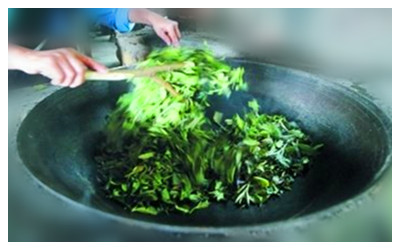
Processing of Tea
 All tea comes from one plant: camellia sinensis, The types of teas that we see today are determined by factors such as soil conditions, climate, altitude and the manufacturing process. The role of the tea master plays a large part in determining the quality of the tea. It is his job to determine when each part of the process is complete. Here we will introduce processing of Chinese Tea.
All tea comes from one plant: camellia sinensis, The types of teas that we see today are determined by factors such as soil conditions, climate, altitude and the manufacturing process. The role of the tea master plays a large part in determining the quality of the tea. It is his job to determine when each part of the process is complete. Here we will introduce processing of Chinese Tea.Picking: Tea leaves and flushes, which include a terminal bud and two young leaves, are picked from Camellia sinensis bushes typically twice a year during early spring and early summer or late spring.
Withering/ Wilting: The tea leaves will begin to wilt soon after picking, with a gradual onset of enzymatic oxidation. Withering is used to remove excess water from the leaves and allows a very slight amount of oxidation. The leaves can be either put under the sun or left in a cool breezy room to pull moisture out from the leaves.
Maceration: Known in the Western tea industry as "disruption" or "leaf maceration", the teas are bruised or torn in order to promote and quicken oxidation. The leaves may be lightly bruised on their edges by shaking and tossing in a bamboo tray or tumbling in baskets.
Orthodox: hand rolled whole leaf and paddles are used to extract essential juices
Cut, tear, and curl : this method where leaves are chopped into tiny pieces, then rolled into tight balls by machines instead of being rolled by hand. This was originally intended for low grade teas and highly suited for teabags. Large tea producers in all major Sri Lanka now use this method and 80% of India’s tea producers use this method
Oxidation / Fermentation: For teas that require oxidation, the leaves are left on their own in a climate-controlled room where they turn progressively darker. This is accompanied by agitation in some cases which releases tannins. (There is a misuse of the term fermentation; in reality only pu-erh uses the fermentation process; where compressed tea is sprayed with water and covered up. Aging, heat and humidity will encourage micro-organisms and bacteria to develop a woody, less astringent tea).
Fixation: Moderately heating the leaves to stop the oxidation at a desired level.
Sweltering / Yellowing: Unique to yellow tea, warm and damp tea leaves are allowed to be lightly heated in a closed container, which causes the previously green leaves to turn yellow due to chlorophyll transformation.
Rolling / Shaping: The damp tea leaves are then rolled to be formed into wrinkled strips, by hand or using a rolling machine which causes the tea to wrap around itself. This rolling action also causes some of the sap, essential oils, and juices inside the leaves to ooze out, which further enhances the taste of the tea.
Drying: Typical ways of ‘finishing’ the tea so its ready for market includes panning, sunning, air drying, or baking (baking is the most common method).
Aging / Curing: Some teas require additional aging, secondary fermentation, or baking to reach their drinking potential. For instance, a green tea pu-erh, prior to curing into a post-fermented tea, is often bitter and harsh in taste, but becomes sweet and mellow through fermentation by age or dampness. More about pu-erh below. Flavored teas are manufactured in this stage by spraying the tea with aromas and flavors or by storing them with their flavorings such as jasmine or rose petals.







 Ask Questions ?
Ask Questions ?